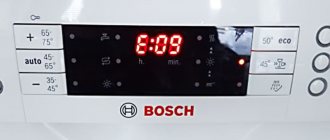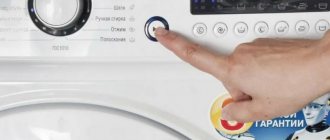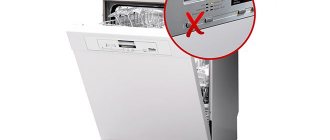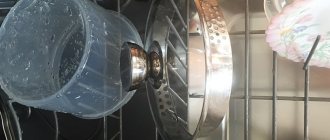Differences in dishwasher models
One of the most common differences between dishwashing machine models is the banal name of the buttons.
For example, Power SCRUB PLUS or REGULAR WASH may be called WASH or ECO depending on the dishwasher model as well as the country in which you are located. Another important difference is the presence of a display that can display error codes or its absence. In this case, the program indicator button lights up to tell you there is a problem.
As a reminder, model numbers are usually found on the top or lip of the door.
See also -
Aquastop system in dishwasher hoses to protect against leaks
Water does not flow in or drain out
We have discussed one reason in detail - this concerns the Aquastop system, the second may be due to a clogged filter. Cleaning it can be done quite easily without special technical knowledge - unscrew the fill hose, carefully pull out the mesh filter and rinse it under running water.
The filling valve located immediately behind the filter may also be faulty, but it is not repaired, but simply replaced with a new device. Details of the repair can be seen in videos, of which there are many on the Internet.
Sometimes this happens: water enters the unit, but the machine freezes in the rinse mode, in this case there are only three reasons:
- The drain filter is clogged - it can be easily solved on your own.
- The water drain hose is kinked.
- The pump requires repair or replacement.
In the first case, everything is simple: at the bottom of the working chamber (tank) there is a coarse mesh filter, and a fine filter element is located nearby. It will take you no more than 10 minutes to remove and clean.
You can find out the condition of the hose by looking behind the car and visually determining its condition; if everything is normal, then the problem is not in it. To get to the pump, you will have to disassemble almost the entire car, since it is located at the very bottom; in addition, the car is turned upside down. Typical pump malfunctions are clogging with foreign objects, and the plastic impeller very often breaks or rotates on the axis due to blocking by a foreign object.
Important! Replacing the pump is a fairly complex dishwasher repair, so realistically assess your capabilities before you start disassembling the equipment.
Before replacing the drain pump, it is better to ring the voltage supply wires to ensure their integrity. If you find a defect or break, replace it, but observe the cross-section size.
Drain pump
Starting a test cycle
Bosch dishwashers have a test mode that can be run as a troubleshooting measure.
The method to run this test process is similar across the Bosch range, so if your machine's functions seem to differ from those described below, it's worth experimenting as the process is similar with only minor differences. To start the test mode, hold down the POWER SCRUB PLUS and REGULAR WASH buttons. Holding down the ON/OFF button may also help. The indicator above them should blink.
You can now check the status of each program by clicking a button, or you can run a full testing period.
Press the Power SCRUB PLUS and REGULAR WASH buttons. The electronic device will start and when the selected mode has ended, if you do not have a display, the indicator on your dishwasher model will light up if a fault has been detected.
Poor cleaning of dishes
Recently, one can increasingly come across complaints from dishwasher owners that the equipment cannot fully cope with its work, and it requires repairs, since the dishes at the end are not clean enough, and therefore they need to be washed manually. The reasons for this may be different: the wrong mode was selected, or the water temperature did not meet the norm, or failure of internal parts of the equipment.
In addition, an important point is that if the pressure of the water jets is not strong enough, the remaining food will not be washed away in the time allotted for the dishwasher to operate. Also, the reason may be an insufficient number of jets produced or their speed will be insufficient, which means that the thrust will not be able to force the rocker arms to rotate sufficiently, as a result of which some area of dirty dishes will be uncleaned.
The reasons for the insufficient pressure of some jets may be the following:
- nozzles clogged with debris;
- clogging in the filter area, resulting in not enough water getting into the pump;
- a part such as a pump impeller wears out and does not produce the required pressure;
- wear of one or more bearings or breakdown inside the engine, which leads to a decrease in the number of revolutions.
You can clean the nozzles yourself, and it does not require opening the dishwasher body. It is enough just to remove one or another rocker arm and carefully clean the injectors with a toothpick or needle.
Meaning of fault indicators
CLEAN
Temperature sensor malfunction. If this is the case, the test cycle will be very short as the instrument will stop testing as soon as this is detected.
RINSE/DRY
Water/tank fill sensor. If this problem occurs, the test cycle will not be completed due to the fact that the dishwasher cannot determine the correct water level simply by filling/draining over and over again.
WASH
Heating fault. Check the heating element.
Meanings of error codes on the display
If your Bosch dishwasher has a display panel, after completing the test cycle, an error code will be displayed if a fault is detected.
Error codes are interpreted as follows:
0 – no errors were detected.
1 – Water sensor or filling fault.
2 – Heating fault.
4 – Water filling error. This may also appear as an F on the display during a normal cycle.
8 – Temperature sensor malfunction.
When troubleshooting a Bosch dishwasher, performing the test cycle above is a good start in diagnosing the problem. The result will give you an idea of where the problem lies and what repairs will be needed to fix the problem.
Drain system clogged
Food residues and debris can create a blockage not only inside the drain hose, but also at the connection to the sewer. As a result of such a clog, the dishwasher will take in water and not drain it. You can fix the problem yourself. To do this, you need to clean the system.
First, you need to disconnect the device from the power supply, and then disconnect the water drain hose at the place where the connection to the sewer occurs. It should be placed in a previously prepared container. After this, the unit must be turned on again and the “Drain” function must be activated. If water flows out of the hose under a large set, then a blockage has formed at the connection with the sewer, and cleaning is required. If the pressure is weak, then the plug is located inside the drain hose.
Basic troubleshooting
If something goes wrong when starting a wash cycle on your Bosch dishwasher and it doesn't work, stay calm. This could be a minor issue, especially if you just installed it.
Power check
Make sure the power cord is connected correctly and the switch does not trip.
Airing the hose
After this, check whether the hose is airy, especially if it was not purged before installation, it may have air bubbles inside, which retains water.
To do this, disconnect the water supply hose from the dishwasher and run some water through it before reinstalling the hose.
The wash cycle is interrupted
The Bosch dishwasher does not fill with water if the previous cycle was interrupted. Reset your dishwasher by pressing and holding the “Start” button for at least three seconds.
Depending on the model, you can also press the “Cancel-Reset” button to reset. Select a new cycle and click “Start”.
Water supply
Check the water supply hose under the sink. If it is turned off or blocked for any reason, the dishwasher will generate a program error and will not be able to fill the tank with water, even if the water supply returns within a few seconds.
Filter hose
Most Bosch dishwashers have a small filter inside the hose to prevent foreign particles from the water supply from entering the dishwasher.
Disconnect the hose and remove the filter inside. Then clean it thoroughly to remove foreign elements and reinstall it.
Water pressure
Make sure you have enough water pressure to start the dishwasher and operate the pump.
To test, take a 4 liter container and turn the tap to maximum to fill it. If you have enough water pressure to run the dishwasher, the container should fill within 30 seconds.
Fill valve problem
Inside the bottom of the dishwasher, on the back of the panel, there is a water inlet fill valve that operates using electricity.
Unplug the power cord from the outlet or turn off the power to the device using the machine. Remove the panel by unscrewing the two screws on both sides.
Remove the screws that hold the front door panel inside the dishwasher; Pull the door panel down and set it aside.
Close the door to access the water inlet valve. The fill valve has two wires that connect it to the block circuit. Check to make sure they are securely fastened.
Also check the valve for damage or leaks. If it is damaged, buy a new one using your dishwasher model number and replace it; otherwise, contact an appliance repair specialist to do it for you.
What causes most breakdowns?
Unfortunately, in many cases dishwasher malfunctions are caused by users. Owners who do not carefully read the operating instructions create problems for themselves.
The most common causes of their occurrence are:
- incorrect connection of the PMM to the water supply, electrical network and sewerage system;
- violation of the dishwasher operating rules;
- use of detergents, salt and rinse aids not intended for these household devices.
You need to connect the dishwasher with skill or entrust this work to professionals
If the connection to communications is incorrect, the PMM may not work. One example of installation errors is exceeding the maximum length of hoses connected to the water supply and sewerage systems. As a result, the drain pump (hereinafter also referred to as the pump) may not have enough power to pump liquid into the sewer, and water from the water supply will not flow into the tank in sufficient volume.
By placing dishes with a large amount of dried dirt into the appliance, you risk clogging the dishwasher filter.
Before washing in a PMM, the surface of the dishes must be cleaned of dried and burnt pieces of food - this is one of the important rules of operation. Otherwise, even soaking and prolonged intensive washing will not help to wash kitchen utensils well. In addition, the machine may stop working if the filters, clogged with dirt, stop passing liquid through them. Therefore, clean the filter from grease and dirt after each operating cycle and at least once a week.
If you use household chemicals that are not intended for dishwashers, this may result in poor dishwashing or damage to the unit.
The use of cheap and low-quality preparations leads to poor quality of washing and rinsing. For example, stains with a whitish tint remain on the surface. Sometimes this can cause high levels of foaming and liquid leakage into the pan, causing the dishwasher to stop working and an error code to appear on the control panel.
Abundant foam in the chamber makes it difficult to wash the utensils
In addition to the above reasons, there are also those that arise due to the fault of utility services. Eg:
- tap water hardness level is too high;
- voltage surges in the electrical network, leading to damage to electronic circuits.
If there is a large amount of salt impurities in the water, regenerative salt cannot soften the liquid to the required level. This situation leads to the appearance of lime deposits in the PMM parts and on the walls of the working chamber. The scale that forms on the surface of the flow-through electric heater (hereinafter also referred to as the heating element) does not allow it to heat the water to the required level. Limescale deposits clog the holes in the sprinkler arms, causing the cleaning quality to drop sharply.
This amount of scale is unacceptable for a dishwasher - it urgently needs to be washed with a special cleaning agent
Powerful voltage surges in the electrical network (sometimes up to 380 volts) are fraught with fatal consequences for household appliances. The control units of dishwashers suffer the most from such processes. In most cases, experienced technicians will check and replace the burnt part. But it also happens that you have to change the entire module.
Control triac in the control unit, burnt out due to surge voltage
The last cause of damage to PMM is wear of parts or defects that arise during their production. Over time, this leads to breakdown of the household appliance.
Readers can learn how a dishwasher works and what breaks in it from the following video:











